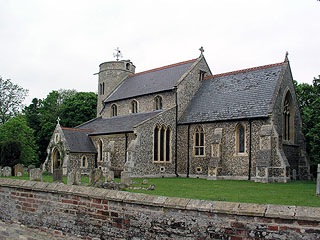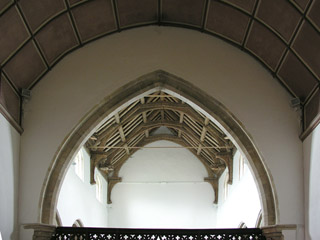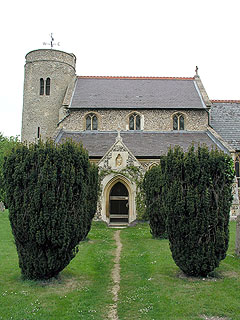What a splendid name for a village! Quite a splendid village, too - although it was somewhat alarming to be overtaken by what looked like a 13-year old on a substantial motorbike.
The church is down a side road, opposite some handsome (if somewhat dishevelled) farm buildings.
The first thing I noticed was the little round tower. It isn't very tall, and it's not much compared to the more dramatic round towers in Norfolk and Suffolk, but it is round - one of only two in Cambridgeshire (the other is at Bartlow). It was built in 1070, and some traces of the contemporary church remain at the west end.
It is either very short, that tower, or the nave is very tall, for the clerestory almost comes up to the top of the tower - giving it a hunched-up, foreshortened look. [Mark adds: the whole effect of the tower was peculiar, as if it was a giant peg had been driven into the graveyard to stop the rest of the church from sliding down the slope beyond.]
The interior reveals the usual hybrid of periods. The chancel is of the early 13th century, the nave was much renewed in the 14th century and there is a splendid, and modest, 15th century clerestory and roof.
The roof was my favourite thing, I think - hammerbeams alternate with tiebeams, and there are angels on the hammers. They are over the windows, so one can see them properly for once!
There is a chancel screen (placed there in the last big restoration of 1878, according to the little guidebook) and a much-restored parclose screen in the north aisle. The church deteriorated a lot between the 17th and 19th centuries, so the Victorian restoration was pretty thorough, but it's still a charming little place.
St Peter was open when we visited, and I recall that there are keyholders listed.


